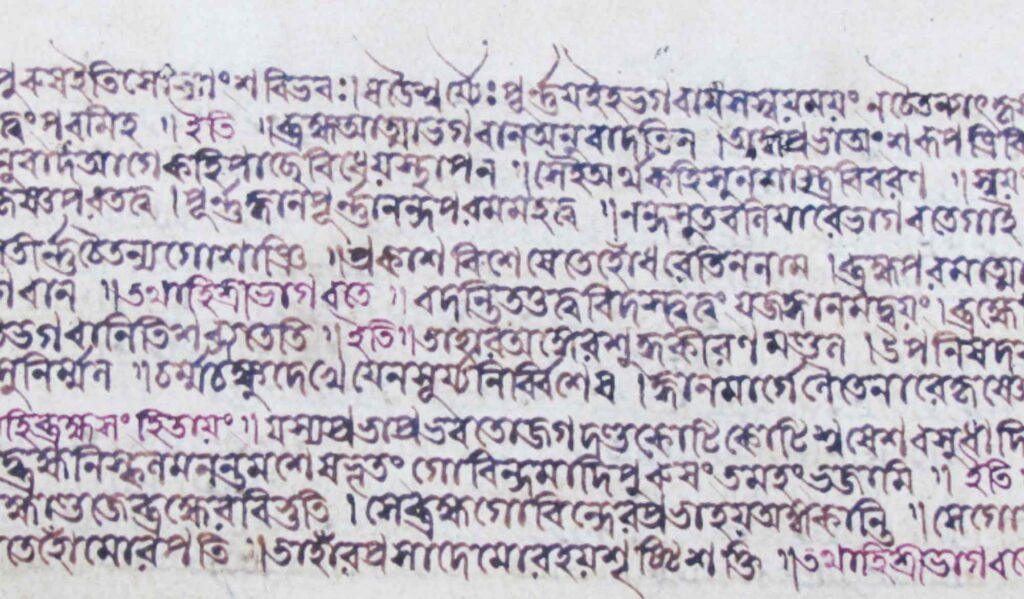Vaiṣṇava Siddhānta Mālā Part 1 – Chapter Two
Bhagavān Ekmātra Parama-tattva
(Bhagavān Alone is the Absolute Truth)
Question: Who is Bhagavān?
Answer: He who creates all jīvas and inanimate matter by His acintya-śakti (inconceivable potency), and enters into them in the form of Īśvara (the Controller), who transcends them and is beyond the reach of the mind, who manifests a form of sac-cid-ānanda through His para-śakti (superior energy) and is the object of bhakti for the jīvas – His name is Bhagavān.
Question: What is the potency of Bhagavān?
Answer: We cannot fully comprehend the power of Bhagavān. That is because that power has no limit, and we are limited. That is why His power is called parā-śakti (superior energy). What is extremely impossible for us, is totally possible for the parā-śakti that He wields. All opposite natures are easily harmonised by that potency.
Question: Then is Bhagavān inferior to this śakti?
Answer: It is not that Bhagavān is one object and His potency is another object. Just as the dāhika-śakti (potency for burning) in fire is inseparable from fire, so also, Bhagavān’s energy is inseparable from Him.
Question: If Bhagavān is the only para-tattva, then why did Mahāprabhu give instructions on kṛṣṇa-bhakti?
Answer: Aiśvarya (all sovereignty), vīrya (all power), yaśa (fame), śrī (beauty), jñāna (knowledge), and vairāgya (renunciation) – these are the six eternal attributes of Bhagavān. The different forms of Bhagavān appear according to whether these attributes are expressed to greater or lesser degrees. When there is a predominance of aiśvarya (opulence), then Nārāyaṇa, the Lord of the spiritual sky, appears. When His beauty or sweetness is dominant, then the Moon of Vṛndāvana, Śrī Kṛṣṇa appears. Thus, Śrī Kṛṣṇa is the highest manifestation of Bhagavān.
Question: How many types of forms does Bhagavān possess?
Answer: He possesses only one spiritual form which is parama-sundara (supremely beautiful), paramānandamaya (full of supreme bliss), sarvākārṣaka (all-attractive), līlāmaya (replete with pastimes) and viśuddha-prema-gamya (perceived through pure prema). According to the various natures of different jīvas, His eternal form manifests to them in an unlimited number of ways. Yet according to their various natures, the jīvas think of all His many, many forms as different. The form of Śrī Kṛṣṇa is the nityānanda-svarūpa (the form of eternal bliss).
Question: What is Śrī Kṛṣṇa’s līlā (pastimes)?
Answer: The most supremely charming section within the spiritual world is called Śrī Vṛndāvana. There, sac-cid-ānanda Śrī Kṛṣṇa exists in the form of Śrī Śrī Rādhā-Kṛṣṇa, in order to perform eternal līlā. When the jīvas manifest a form of bliss, then they achieve the eligibility to enter Śrī Kṛṣṇa’s eternal līlā amongst the female companions of paramānanda-svarūpiṇī Śrī Rādhikā, the embodiment of supreme bliss. In that līlā, there is no influence of lamentation, fear or death. The only assistant to this līlā is perpetual bliss.
Question: What are the hinderances to attaining the līlā of Śrī Kṛṣṇa?
Answer: There are two hinderances: jaḍa-buddhi (mundane intelligence), and jaḍa-cintātita (that which is beyond mundane intelligence) meaning in other words nirviṣeśa-buddhi (impersonal mentality).
Question: What is mundane intelligence?
Answer: That which narrows one’s intellect to material time, space, objects, desires, thoughts and actions – that is known as mundane intelligence. Through material intelligence, one sees Vṛndāvana-dhāma as a mundane place. It divides time into three divisions: past, present, and future. One considers temporary objects as real; one desires temporary happiness in Svārga etc. Apart from mundane thoughts, one cannot think of anything else. One considers such activities as developing civilisation, politics, science, industry and worldly progress etc. as one’s ‘duty’.
Q. What is nirviṣeśa-buddhi (impersonal mentality)?
Answer: That dharma by which all objects in the material world are distinct from each other is known as ‘viśeṣa’ (distinctions) When one rejects material thoughts, one rejects viśeṣa or material distinction, then one’s intellect falls into impersonalism. One no longer perceives any difference between objects; unavoidably, one is led to the state of nirvāṇa, or merging into Brahman. In this state there is no bliss. When there is no spiritual happiness, the chance for attaining prema is lost. Though Śrī Kṛṣṇa’s līla is beyond matter, still it is replete with cinmaya-viśeṣa (spiritual distinctions).
Question: If Śrī Kṛṣṇa’s līla is beyond matter, then how was it perceived at the end of Dvārpara-yuga in the western provinces?*
*Western provinces’ refers to Uttar Pradesh which is west of Bengal.
Answer: Although Śrī Kṛṣṇa’s līlā is not perceivable to the mundane senses, still due to Śrī Kṛṣṇa’s acintya-śakti (inconceivable potency), it manifests in this material world. Although it is manifested here, it never mixes with matter nor does it become subservient to the laws of matter. Śrī Kṛṣṇa’s līlā is manifest (prakaṭa) and unmanifest (aprakaṭa) – yet both states are entirely spiritual. Śrī Kṛṣṇa’s līlā is purely without any limitation and only performed in Śrī Vṛndāvana. When it manifests in this world, or in the heart of the jīva – this is only due to the acintya-śakti and by His mercy. Though it manifests in this world, those with a mundane intellect are cheated of His pastimes and see faults in Him by material reasoning. Like Jagāi and Mādhāi, those who become free from mundane consciousness will be able to fully understand these philosophical truths; they become free from faults and become attracted to those pastimes. Without understanding śrī-kṛṣṇa-tattva (the philosophical truths about Śrī Kṛṣṇa) one can never attain rasa (devotional mellows).
Question: Śrī-kṛṣṇa-tattva is found within the teachings of Vaiṣṇava dharma. What happens to those who follow other dharmas?
Answer: Those other dharmas that teach about the worship of Īśvara, Paramātmā and Brahman, point towards kṛṣṇa-tattva. As a jīva progresses, he finally attains bhakti for Śrī Kṛṣna. When one attains perfection in defective dharma, one eventually comes to kṛṣṇa–bhakti. Supreme knowledge for the jīva means having the highest understanding of śrī-kṛṣṇa-tattva.









